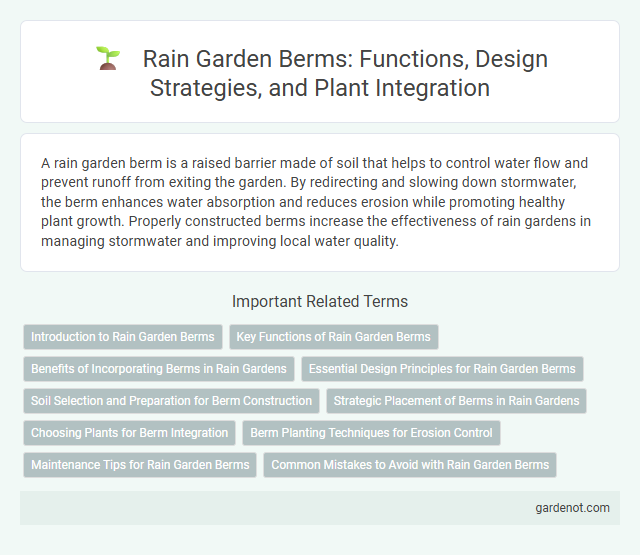A rain garden berm is a raised barrier made of soil that helps to control water flow and prevent runoff from exiting the garden. By redirecting and slowing down stormwater, the berm enhances water absorption and reduces erosion while promoting healthy plant growth. Properly constructed berms increase the effectiveness of rain gardens in managing stormwater and improving local water quality.
Introduction to Rain Garden Berms
Rain garden berms are raised barriers typically constructed from soil or mulch to direct and retain stormwater within a rain garden. These berms enhance water absorption by controlling runoff flow and preventing overflow, which optimizes the rain garden's ability to filter pollutants. Proper berm design ensures effective water infiltration and supports healthy plant growth, contributing to sustainable urban drainage systems.
Key Functions of Rain Garden Berms
Rain garden berms play a crucial role in directing and containing stormwater runoff within the garden, preventing erosion and promoting infiltration. These raised edges help to slow down water flow, allowing sediments and pollutants to settle before water seeps into the soil. By enhancing water retention and distribution, berms contribute significantly to the overall effectiveness of rain gardens in managing urban runoff.
Benefits of Incorporating Berms in Rain Gardens
Rain garden berms enhance water retention by creating a natural barrier that slows runoff, promoting increased infiltration and reducing soil erosion. These berms improve pollutant filtration by directing water through vegetation and soil layers, which helps absorb nutrients and contaminants before reaching storm drains or groundwater. Incorporating berms also supports plant health and biodiversity in rain gardens by maintaining optimal moisture levels and preventing waterlogging.
Essential Design Principles for Rain Garden Berms
Rain garden berms must be constructed with compacted, stable soil to effectively contain and direct runoff while preventing erosion. They require an appropriate height and slope--typically 6 to 12 inches tall with a gentle slope--to facilitate water infiltration and avoid overflow. Integrating native vegetation on berms enhances soil stability and promotes pollutant filtration within the rain garden system.
Soil Selection and Preparation for Berm Construction
Selecting well-draining, nutrient-rich soil with a balanced mix of sand, silt, and clay is essential for rain garden berm construction to ensure effective water infiltration and structural stability. Proper soil preparation involves removing existing vegetation, loosening compacted soil, and incorporating organic matter such as compost to enhance moisture retention and nutrient availability. Establishing an optimal soil profile supports berm durability and promotes healthy plant growth, crucial for managing stormwater runoff efficiently.
Strategic Placement of Berms in Rain Gardens
Rain garden berms strategically placed around the perimeter control water flow, enhancing infiltration and preventing surface runoff. Proper berm elevation and contouring direct excess stormwater to infiltration zones, maximizing pollutant removal and groundwater recharge. Placement on downhill sides captures overflow efficiently, promoting sustainable stormwater management.
Choosing Plants for Berm Integration
Selecting drought-tolerant and native plants for rain garden berm integration ensures enhanced water absorption and soil stabilization. Deep-rooted grasses and perennials like Switchgrass (Panicum virgatum) and Black-eyed Susan (Rudbeckia hirta) promote erosion control and nutrient filtration. Incorporating diverse species that thrive in fluctuating moisture levels maximizes the berm's ecological function and resilience.
Berm Planting Techniques for Erosion Control
Rain garden berms are designed to slow water runoff and promote infiltration, making effective berm planting techniques essential for erosion control. Utilizing deep-rooted native grasses and perennials stabilizes the berm soil, while layering plants with varying root depths enhances structural integrity. Incorporating mulch and ground covers further protects the berm from surface erosion and supports moisture retention.
Maintenance Tips for Rain Garden Berms
Regularly inspect rain garden berms for erosion or sediment buildup to maintain proper water flow and prevent overflow. Trim vegetation on berms to promote healthy plant growth while avoiding overgrowth that can impede drainage. Periodic replenishment of soil and mulch ensures structural integrity and supports the berm's ability to effectively direct stormwater runoff.
Common Mistakes to Avoid with Rain Garden Berms
Rain garden berms must be carefully designed to prevent erosion and water bypass, which are common mistakes that reduce garden effectiveness. Avoid using low-quality soil that compacts easily, as this impedes drainage and causes pooling. Ensuring proper height and slope is crucial to maintain water retention and support plant health in the rain garden.
Rain garden berm Infographic

 gardenot.com
gardenot.com